No-Touch Growing
Here where I live in Northeast Ohio we certainly don’t have a lack of access to high quality, indoor-grown leafy greens, whether they're from a greenhouse or indoor vertical farm. In fact, a new greenhouse grower has just come online called Fresh Local Produce of Ohio, selling under the Free! Leafy Greens brand. Free because they utilize the Green Automation system of fully automated growing.
Helena Borenius at Green Automation got me in touch with Mark Chenoweth, executive VP of sales and marketing at Fresh Local Produce of Ohio, to get the rundown on some of the details. Here’s our chat:
JP: Can you tell me how the operation came about?
MC: About three years ago, we had the opportunity to see the greenhouse technology from Green Automation. The robotic greenhouse technology produces lettuce 365 days a year in a totally controlled environment—the entire process is hands-free from sowing to packaging. Harvesting and packaging takes place in a refrigerated space, increasing the shelf life of the product because it’s kept cool from the time it’s cut. It took three years of planning and construction to realize this vision here in Hudson, Ohio.
JP: Why did you choose Hudson? Is there room to expand?
MC: Because we wanted to support the local movement, we decided to build the facility to support local retailers and restaurants. There is a plan to expand the operation in the next year or two, doubling our production volume.

JP: How long were you in the construction phase?
MC: From site preparation to the start of the operation took a little over 14 months.
JP: What kind of greenhouse did you build? How big is it?
MC: We chose a technology from Finland called Green Automation. The 2-acre, robotic greenhouse uses over 16,000 gutters to grow the lettuce hydroponically.
JP: Is there anything unique about the setup (aside from full automation)?
MC: The greenhouse environment is tightly controlled from the amount of light the plants receive every day to the temperature and humidity, creating the perfect conditions for the plants to grow. Also, the greenhouse environment operates at a positive pressure, reducing the risk of outside pests, mold, etc. from entering the building. Because of this, we are able to offer a product that is free of pesticides and fungicides. Also, we tightly control our water systems to provide the plants with the purest, nutrient-filled water. Our operation is unique in that we harvest (cut) our product when the plants are in our refrigerated processing room—this ensures the lettuce stays fresh longer.
JP: Why did you go fully automated from the beginning?
MC: The fully automated system sustainably provides premium lettuce product 365 days a year while using about eight times less labor. Our company offers consumers “Hands-Free Cultivation”—no human contact with the product from start to finish. Consumers want their food to be pure; our state-of-the-art facility provides the safest growing environment for America’s dinner table.
JP: Tell me about what you're growing.
MC: We are growing three varieties of lettuce. Our main variety is a green leaf, which is great-tasting, crisp and hearty. This is mixed with a unique red leaf and great-tasting arugula for our three products.
JP: How do you defend against pests?
MC: We have several lines of defense against pests—the main deterrent is our pressurized greenhouse environment. We use biological integrated pest management to ensure pests do not enter our greenhouse environment.
JP: Are you only selling to grocery stores right now? How far are you shipping?
MC: We are currently selling our product in local retailers within 150 miles of our facility, providing the freshest product available.
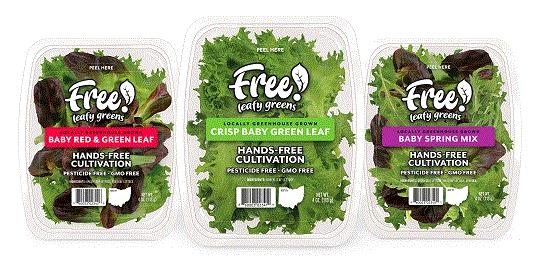
JP: Tell me about your packaging.
MC: We use a clear plastic tray with a unique film covering that is 100% recyclable. The film covering has a re-sealable flap so a consumer can take the amount they want to eat while easily sealing the rest of the container for use.

COVID-19 Greenhouse Best Practices
COVID-19 seems to be here to stay for the foreseeable future and greenhouses of all types need to find ways to operate safely. Thanks to multiple sources in the industry, Ball Publishing has been able to put together a best-practices list for greenhouses (special thanks to Bill Calkins for compiling this list!):
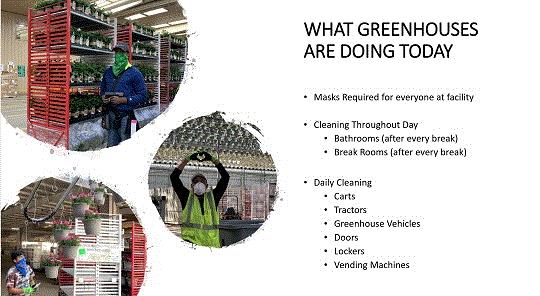
-
DO NOT ask your existing staff to do the extra cleaning—hire a crew or talk to your normal cleaning/janitorial crew to add additional staff; they will most likely have people available with so many other businesses closed
-
Isopropyl alcohol and hand sanitizer/cleaner for people
-
Quat Disinfectant Cleaner or 3% Bleach solution for surfaces and equipment
-
Watch all “touchpoints”—handles, seats, knobs, microwaves, time clocks
-
Remove lids from trash cans, prop open doors
-
Limit the number of people in bathrooms
-
Reduce chairs in your break room down to nine or fewer
-
Use tape on the floor to indicate safe distancing
-
It should start with management—wear masks and eliminate face-to-face meetings with multiple people
-
Encourage staff to clean all personal tools, including phones, frequently—these are touched all day and often shared
-
Ask your staff to give input on areas to be cleaned
-
Encourage managers to check in with employees frequently: how are they feeling?
-
Don’t punish staff for missing work if they feel ill—otherwise they won’t take precautions
-
Hand out masks or bandanas—don’t make staff buy their own
-
Many of these precautions should stay in place past the pandemic
Bill conducted a Zoom meeting about this very topic recently with Jeff Back, director of greenhouse operations at Four Star Greenhouse in Michigan, and Abe VanWingerden, owner of Metrolina Greenhouses in North Carolina. You can CLICK HERE to see the video.
Have you found other practices to be effective in your operation? Let me know at jpolanz@ballpublishing.com.

Greenhouse Tech Team Online
Are you running into questions about your greenhouse crop and don’t know who to turn to? Now there’s a Facebook solution for you: Greenhouse Tech Team, moderated by Ball Horticultural Co. This private Facebook page is designed just for greenhouse growers to engage, interact, ask questions, share tips and find more production details.
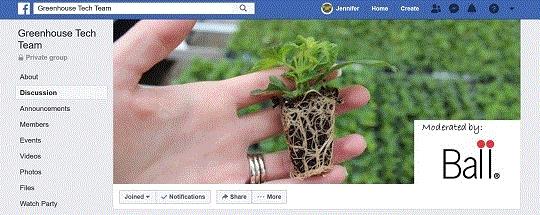
Right now the page has more than 800 members and topics include everything, from current recommendations for Impatiens Downy Mildew to class-specific strategies for holding and delaying crops. Members include growers, university researchers and other industry experts. You can find the page by searching the term “Greenhouse Tech Team” on Facebook.
United Fresh Live!
In the last newsletter, I told you about Cultivate’20 going virtual—in this issue, we’ll explore the concept further with United Fresh 2020 Live! This actually was announced first and will feature a virtual trade show, live video general sessions, online workshops, happy hours, morning yoga, coffee talks and more ways to connect. Best of all, it’s all free.
The event will go live the week of June 15, and will be archived and available for viewing at any time through September 1, 2020. You can see the schedule by CLICKING HERE.

Also, don’t forget United Fresh has lots of great resources on its website that it updates regularly. CLICK HERE for an updated list of those resources and CLICK HERE to register.
Webinars Galore
One of the most effective ways to get production information out there in light of COVID-19 is through webinars. There are a couple of interesting ones coming up from Heliospectra AB:
The lighting company is offering a series of greenhouse production webinars over the next two weeks on "Greenhouse Operations: The New Normal After COVID-19." This one talks about updating standard operating procedures to protect crops and employees.
May 7: "Cultivating Local Market Demand for Herbs and Potted Plants." This one starts at 10:00 a.m. Eastern and will be led by Andrew Fuller of Neame Lea Fresh, part of the U.K.’s Bridge Farm Group; and Ida Fällström, plant and light research director at Heliospectra AB.
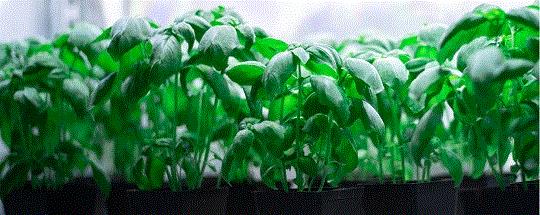
May 14: "Greenhouse Lighting for Transplant and Finish of Herbs and Vegetables." Tune in at 11:00 a.m. Eastern to hear Dr. Roberto Lopez of Michigan State University talk about adjusting to changes in seasonal daylight and photoperiod to improve crop performance, color and appearance.
CLICK HERE to register for any of these free webinars and to see archived versions.

CEAC Extras
Earlier this year, I had the distinct pleasure of interviewing some of the most innovative minds in CEA for a feature on the 20th anniversary of the Controlled Environment Agriculture Center (CEAC) at the University of Arizona. I logged hours of interviews and thousands of words of notes for that story, which can be found in the latest copy of Inside Grower, mailing with the May issue of GrowerTalks/Green Profit. It also can be found HERE.
Of course, because of limited space, I could only fit a fraction of the research conducted over the years at CEAC in the article. There’s a newer research project that I couldn’t fit in the story that I wanted to highlight here—a collaboration between the University of Arizona and the Navajo Nation. Here’s what got cut:
Yet another example of collaboration is the current Indige-FEWSS project, which develops technology solutions with semi-transparent photovoltaics integrated into off-grid greenhouse systems for food production, with water treatment systems for high-quality drinking water to help address challenges faced by indigenous people and other communities that often lack access to energy, water and food infrastructure.
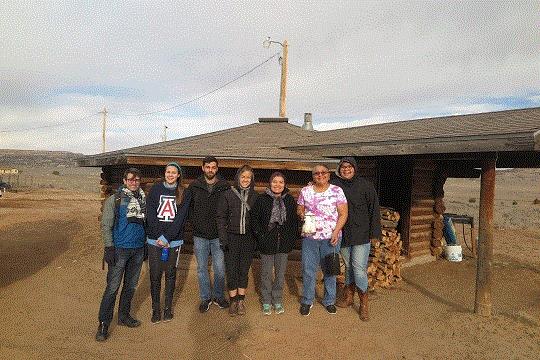
Indige-FEWSS Fellows and UA faculty travel to the Navajo reservation Spring Break 2019 for cultural immersion.
The project is a collaboration between University of Arizona researchers and colleagues at colleges and in the community in the Navajo Nation. CLICK HERE for more details on the program.



As always, feel free to email me at jpolanz@ballpublishing.com with comments, questions, news and views.
Until next time, stay safe and be healthy,

Jennifer Polanz
Editor-at-Large
Inside Grower
This email received by 24,316 loyal readers!
Interested in advertising in Inside Grower? Contact Paul Black or Kim Brown and they'll show you how easy, effective and affordable it is.